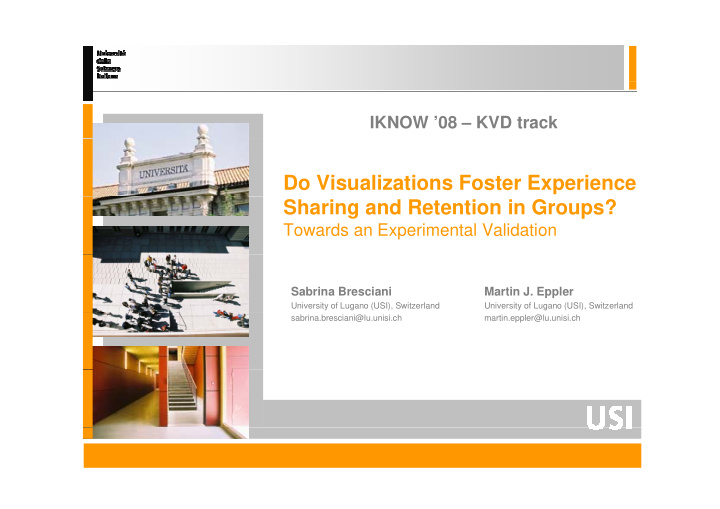



IKNOW ’08 – KVD track Do Visualizations Foster Experience Sharing and Retention in Groups? Towards an Experimental Validation Sabrina Bresciani Martin J. Eppler University of Lugano (USI), Switzerland University of Lugano (USI), Switzerland sabrina.bresciani@lu.unisi.ch martin.eppler@lu.unisi.ch
Agenda 1. Context 2. Research Design 3. Experiment p Design Measures and hypotheses Measures and hypotheses Preliminary results 4. Conclusion Q&A USI
1. Context Research question: does visualization support knowledge intensive group work in organizations? - Meetings in organizations - Not only decision making - Supported by visualization: visual metaphors, maps, sketches, diagrams… - Main focus: computer supported (GSS), face to face USI
http://www.knowledge-communication.org/overview-gallery.html USI
QT QL qt 2. Research Design Mixed methods design: g 1 1. Identify main characteristics of a Identify main characteristics of a visualization mediating collaborative Qualitative part: knowledge work g broad, broad understaning the context 2. 2. Matching widely used visualizations in Matching widely used visualizations in organizations, with typical group activities Quantitative part: focused f d 3. Experiment : compare (I) optimal visualization support ( ) p pp (II) sub-obtimal visualization support (III) no visualization support USI
3. Experiment design QT QL qt Experiment : 3X2 Groups of 5 managers Groups of 5 managers Topic: strategy implementation problems 3 Conditions (independent variable): 3 Conditions (independent variable): • Optimal* visualization support • Suboptimal* visualization support • unsupported (no computer, only ( flipchart) 2 tasks: • knowledge sharing • evaluation (ranking) evaluation (ranking) USI • *assigned as
3. Experiment design Condition 1: optimal visualization support Knowledge sharing: iceber visual metaphor Evaluating options: 2X2 Matrix Condition 2: sub-optimal visualization support Knowledge sharing: timeline Knowledge sharing: timeline Evaluating options: concept map Evaluating options: concept map USI
3. Experiment: measures Subjective Satisfaction Validated scales with process with process Briggs, 2006 and outcome Subjective Equality of Equality of Validated scale Zmud 2002 Validated scale, Zmud 2002 Participation Objective Time speaking from the recordings ( (Visual) support ) pp Freedom of Subjective j Non validated scale Participation Objective Productivity Productivity Number of relevant items Group level Objective Retention Number of relevant items recalled ( (memorability) b l ) Individual level Control variables: familiarity with topic, familiarity with GSS, like for visualization, comfortable with English, facilitator did a good job, conflict, gender, age, years of experience, mother tongue, facilitator role, group (11) USI
3. Experiment: hypotheses H1 Using an appropriate visual support for a task has a positive impact on satisfaction compared to using no visual support i f i d i i l H2 Using an appropriate visual support for a task has a positive impact on equality of participation compared to using no visual support equality of participation compared to using no visual support H3 Using an appropriate visual support for a task has a positive impact on freedom of participation compared to using no visual support H4 Using an appropriate visual support for the task has a positive impact on productivity compared to using no visual support H5 Using an appropriate is al s pport for a task has a positi e impact on H5 Using an appropriate visual support for a task has a positive impact on retention compared to using no visual support Sub-optimal visualization tentative hypothesis: above the un-supported condition and below the optimal visualization support USI
3. Experiment: provisional analysis Partial data: 56 subjects in 11 groups Partial data: 56 subjects in 11 groups Component 1 1 2 2 3 3 4 4 satisfaction process 1 ,824 ,382 ,203 -,020 satisfaction process 2 ,825 ,348 -,075 -,109 satisfaction process 3 ,814 ,265 ,191 ,022 satisfaction process 4 ,749 ,260 ,244 ,037 satisfaction outcome 1 ,167 ,904 -,004 ,093 satisfaction outcome 2 Validated scales ,355 ,814 -,063 -,049 satisfaction outcome 3 satisfaction outcome 3 ,404 ,719 ,142 ,113 satisfaction outcome 4 ,309 ,879 ,116 ,041 participation equality 1 ,033 ,025 -,107 ,944 participation equality 2 participation equality 2 ,022 022 ,075 075 ,124 124 ,909 909 participation equality 3 -,079 ,036 -,033 ,911 participation freedom 1 ,469 ,069 ,730 ,082 participation freedom 2 ,238 ,036 ,860 -,007 New scale N l participation freedom 3 -,016 ,068 ,913 ,016 participation freedom 4 ,034 -,004 ,887 -,073 Principal component analysis, varimax rotation Principal component analysis, varimax rotation USI
3. Experiment: provisional analysis Partial data: 56 subjects in 11 groups Partial data: 56 subjects in 11 groups Factor Cronbach’s N of Alpha p items Satisfaction with ,901 4 process p Satisfaction with ,908 4 outcome Validated scales Equality of ,912 3 participation Freedom of ,894 4 participation participation New scale Reliability analysis Reliability analysis USI
3. Experiment: provisional analysis Partial data: 56 subjects in 11 groups Partial data: 56 subjects in 11 groups Compare means Satisfaction Equality of Freedom of Productivity Recall participation participation Vi Visualization supported li ti t d 5 57 5.57 5 60 5.60 6 45 6.45 16 16 12.5 12 5 condition Unsupported condition 5.53 5.03 6.05 12.5 8 ANOVA ANOVA F(2,51)=0.08 F(2,52)=2,62 F(2,52)=2.20 F(2,9)=2.56, F(2,51)=26.03 Effect of visualization p>.05 p<0.5 p=.06 p=.07 p<.01 (overall) Planed contrast: t(52)=2,13, t(52)=1.9, p<.05 t(7)=2.26, p<.05 t(7)=7.00 p<.01 p<.05 visualization supported compared with unsupported t(52)= ‐ .43 p>.05 t(52)=1.01, t(7)= ‐ 2.72 p<.05 Planed contrast: optimal t(7)=-.20 p>.05 visualization compared i li i d p>.05 05 with suboptimal visualization Disclaimer: provisional analysis of partial data! � First experiment indicates positive impact of visualization on group collaboration on group collaboration USI
4. Conclusion Next steps •Collect data for >100 participants •Future: replicate with variants: remote (virtual) group work or in a different cultural context Key insights •Aim of the study: bridge visualization and GSS studies •Experimental approach to understand the effect of visualization for collaborative knowledge work g � Preliminary partial results: visualization has a positive impact USI
Recommend
More recommend